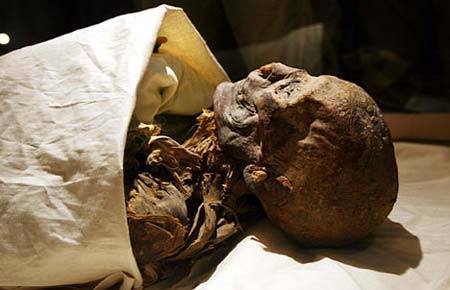Colon cancer is linked with obesity, lack of exercise, and a poor diet high in processed foods.
结肠癌与肥胖、缺乏锻炼、经常吃精细食物的不良饮食息息相关。
However, scientists have also identified genetic mutations connected to the disease.
然而,科学家还检测到基因突变与这种致命的疾病有关。
Researchers at Tel Aviv University are studying the evolutionary history of colon cancer.
以色列特拉维夫大学的研究者目前正研究结肠癌的进化历史。
Microbiologist Rina Arbesfeld is with the university.
里娜·阿贝斯菲尔德是该大学的微生物学家。
She wanted to answer this genetic question: Where do these mutations come from?
她想就以下几个基因问题进行研究:这些基因突变来自哪里?
Our lifestyle?The environment? Our diet?
是因为我们的生活方式吗?还是环境?或者是饮食?
Or did these mutations also exist a long time ago?
基因突变是很久之前就已经存在了吗?
In other words, is the increase in the number of cancer cases today the result of natural evolution alone?
也就是说,当今癌症病例的不断增加难道是自然进化的结果吗?
To answer this question, Arbesfeld turned to an unusual source: Hungarian mummies that were discovered in 1994 in a church.
为回答这个问题,阿贝斯菲尔德开始将重点研究一个非同寻常的资料来源:1994年在教堂里发现的匈牙利木乃伊。

These preserved bodies rested in a cool, dry climate for more than two and half centuries.
这些木乃伊已经在凉爽干燥的环境中保存了近250年了。
They give a rare opportunity to research biologists.
它们为生物学家提供了难得的研究机会。
An embalmer is a person who prepares a body for burial.
入殓师指为死者化妆整仪后将其纳入棺中的职业。
Hungarian embalmers used different techniques than Egyptian embalmers.
匈牙利入殓师会使用不同于埃及的入殓方法。
In ancient Egypt, embalmers removed fluids and internal organs.
在古埃及,入殓师需将死者的体液和内脏取出。
This made mummification of the bodies happen quickly, over a period of two or three months.
这样躯体会在2-3个月时间内迅速“木乃伊化”。
Hungarian embalmers mummified more slowly.
而匈牙利入殓师使尸体“木乃伊化”的时间则慢很多。
They left the fluids and organs intact.
他们完整地保留死者的体液和器官。
This means the mummies have retained tissue that could be better analyzed for evidence of disease.
这意味着木乃伊保存着完整的内脏组织,有利于更详细地分析疾病。
Arbesfeld and her team isolated DNA samples from 22 mummies.
阿贝斯菲尔德与同事从22具木乃伊中抽离出了DNA样本。
Then they sequenced the genetic material in the hunt for mutations.
随后为了寻找基因突变迹象,对所采取的基因材料进行排序。
This was not easy.
这并非易事。
Arbesfeld says that after many tries, her team found one specific mutation in a gene called APC.
阿贝斯菲尔德表示,小组进行了多次尝试之后,终于在结肠腺瘤性息肉基因(APC)中发现了一种特殊的基因突变。
This gene is important.
这种基因对她们的研究十分重要。
The APC gene is known to be involved in the development of cancer.
APC基因与癌症的发展过程有关。
Arbesfeld explains that the APC gene is what she calls the “gatekeeper” for the development of cancer.
阿贝斯菲尔德解释道,APC基因就是她所说的癌症发展的“看门人”。
This information led Arbesfeld to this hypothesis:
阿贝斯菲尔德由此提出一种假设:
If our ancestors with the genetic mutation for colon cancer lived long enough, they would have developed the disease, just like us.
如果,我们那些基因突变的祖先寿命足够长,他们也会像我们一样患结肠癌。
Arbesfeld says her next step is to sequence samples from other sources for a larger follow-up study.
阿贝斯菲尔德还说,接下来会进一步追踪调查,对其它资料源样本进行排序。
She says understanding our genetic past can better explain the present.
她表示,了解基因发展史有利于我们更好的研究当今的基因领域。
And understanding a disease's genetic past can help to handle the disease's future.
了解过去的疾病基因史有助于我们更好地掌握疾病的“发展前景”。
Cancer of the colon kills about 700,000 people a year worldwide.
全球每年死于结肠癌的患者达70万。
However, it is highly treatable when found early.
但是,早期结肠癌治愈率很高。
The study was published in the journal PloS ONE.
此研究报告刊登在《公共科学图书馆期刊》。
I'm Anna Matteo.
本栏目视频字幕与文本并不完全对应,且视频播放缓冲时间较长,敬请谅解!


